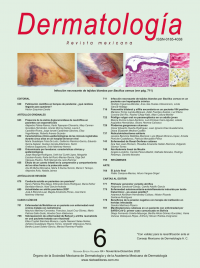Presence of the enzyme β-glucuronidase of neutrophils in patients with sporotrichosis.
Dermatol Rev Mex. 2020; 64 (6): 643-649.
Alejandro Palma-Ramos,1 Karla Tepexpan-Chavarría,1 Mary Carmen González-Hernández,1 Araceli Monroy-Núñez,1 Laura E Castrillón-Rivera,1 Jorge Ismael Castañeda-Sánchez,1 Elisa Vega-Memije,2 Roberto Arenas-Guzmán3
1 Laboratorio de Inmunobiología. Departamento de Sistemas Biológicos, Universidad Autónoma Metropolitana Unidad Xochimilco, Ciudad de México.
2 Departamento de Dermatología.
3 Sección de Micología.
Hospital General Dr. Manuel Gea González, Ciudad de México.
Resumen
ANTECEDENTES: La esporotricosis es una infección fúngica crónica causada por el complejo Sporothrix schenckii; en la histopatología muestra granulomas supurativos, tuberculoides o de cuerpo extraño, formados por histiocitos que rodean un área central de neutrófilos que contribuyen en el sistema de inmunidad inespecífica, en estas células se encuentra la enzima β-glucuronidasa que cataliza la descomposición de los carbohidratos complejos, hidrolizando los residuos de ácido β-D-glucurónico del extremo no reductor de los mucopolisacáridos.
OBJETIVO: Determinar la existencia de la enzima β-glucuronidasa proveniente de neutrófilos en cortes histológicos de siete pacientes diagnosticados con esporotricosis por el departamento de Dermatología y Micología del Hospital General Manuel Gea González de la Secretaría de Salud.
MATERIAL Y MÉTODO: Estudio prospectivo efectuado de enero a diciembre de 2019 en el que se utilizaron siete estudios histopatológicos y se efectuaron tres cortes por muestra, para la realización de las técnicas: hematoxilina-eosina, PAS y para el marcaje de β-glucuronidasa; se utilizó el paquete comercial Cell and Tissue Staining Kit, Goat Kit HRP-AEC System (catálogo número CTS009) R&D Systems, y el anticuerpo primario fue IgG policlonal anti- β-glucuronidasa humana hecho en cabra por los laboratorios Santa Cruz Biotechnology.
RESULTADOS: Se encontró β-glucuronidasa adherida a las levaduras de Sporothrix sp, previamente observadas por la reacción de PAS en todos los cortes estudiados.
CONCLUSIONES: Se encontró β-glucuronidasa proveniente de polimorfonucleares neutrófilos, adherida en la pared celular de las levaduras presentes en los cortes histológicos de los siete pacientes con esporotricosis.
PALABRAS CLAVE: Sporothrix schenkii; esporotricosis cutánea; β-glucuronidasa.
Abstract
BACKGROUND: Sporotrichosis is a chronic fungal infection caused by the Sporothrix schenckii complex, characterized by a suppurative, tuberculoid or foreign body granulomas, formed by histiocytes that surround a central area of neutrophils that contribute to the nonspecific immunity system, in these cells it is found the enzyme β-glucuronidase that catalyzes the breakdown of complex carbohydrates, hydrolyzing β-D-glucuronic acid residues from the non-reducing end of mucopolysaccharides.
OBJECTIVE: To determine the presence of the enzyme β-glucuronidase from neutrophils in histological sections of biopsies of seven patients diagnosed with sporotrichosis by the Dermatology and Mycology Department at Manuel Gea González General Hospital of public health.
MATERIAL AND METHOD: A prospective study done from January to December 2019 in which seven patient histopathological samples were used and three cuts per sample were made for the performance of the techniques: HE, PAS and for the labeling of β-glucuronidase; the commercial package Cell and Tissue Staining Kit, Goat Kit HRP-AEC System was used (catalog number CTS009) R&D Systems, and the primary antibody was goat human anti-β-glucuronidase polyclonal IgG by the Santa Cruz Biotechnology laboratories.
RESULTS: It was found the presence of β-glucuronidase adhered to the yeasts of Sporothrix sp, previously observed by the PAS reaction in all the samples.
CONCLUSIONS: We found β-glucuronidase from neutrophil polymorphonuclear, adhered to the cell wall of the yeasts present in the histological sections of the seven patients with sporotrichosis.
KEYWORDS: Sporothrix schenkii; Cutaneous sporotrichosis; β-glucuronidase.

